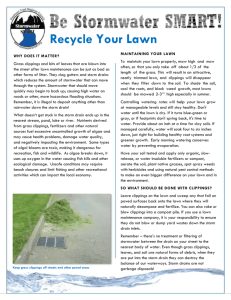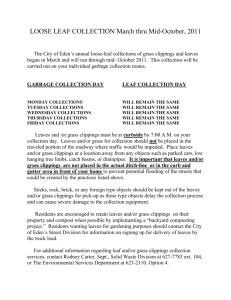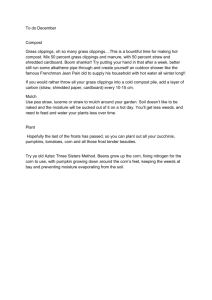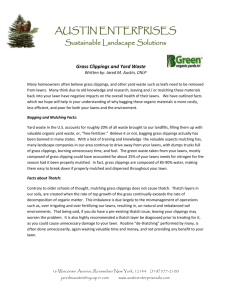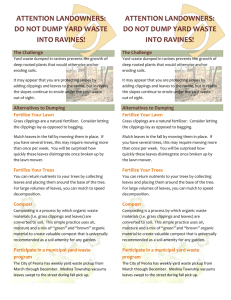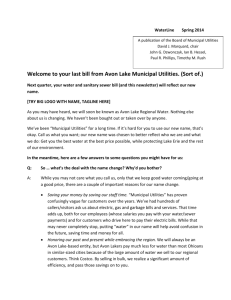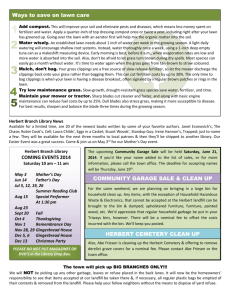yard waste - River Grove Village
advertisement
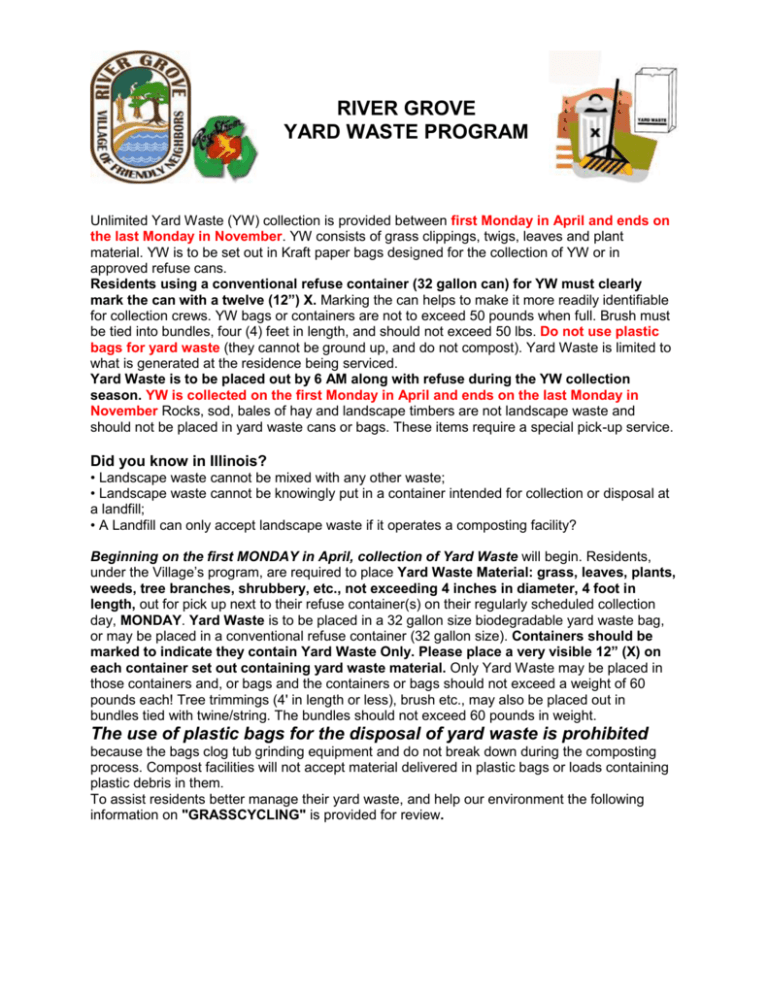
RIVER GROVE YARD WASTE PROGRAM Unlimited Yard Waste (YW) collection is provided between first Monday in April and ends on the last Monday in November. YW consists of grass clippings, twigs, leaves and plant material. YW is to be set out in Kraft paper bags designed for the collection of YW or in approved refuse cans. Residents using a conventional refuse container (32 gallon can) for YW must clearly mark the can with a twelve (12”) X. Marking the can helps to make it more readily identifiable for collection crews. YW bags or containers are not to exceed 50 pounds when full. Brush must be tied into bundles, four (4) feet in length, and should not exceed 50 lbs. Do not use plastic bags for yard waste (they cannot be ground up, and do not compost). Yard Waste is limited to what is generated at the residence being serviced. Yard Waste is to be placed out by 6 AM along with refuse during the YW collection season. YW is collected on the first Monday in April and ends on the last Monday in November Rocks, sod, bales of hay and landscape timbers are not landscape waste and should not be placed in yard waste cans or bags. These items require a special pick-up service. Did you know in Illinois? • Landscape waste cannot be mixed with any other waste; • Landscape waste cannot be knowingly put in a container intended for collection or disposal at a landfill; • A Landfill can only accept landscape waste if it operates a composting facility? Beginning on the first MONDAY in April, collection of Yard Waste will begin. Residents, under the Village’s program, are required to place Yard Waste Material: grass, leaves, plants, weeds, tree branches, shrubbery, etc., not exceeding 4 inches in diameter, 4 foot in length, out for pick up next to their refuse container(s) on their regularly scheduled collection day, MONDAY. Yard Waste is to be placed in a 32 gallon size biodegradable yard waste bag, or may be placed in a conventional refuse container (32 gallon size). Containers should be marked to indicate they contain Yard Waste Only. Please place a very visible 12” (X) on each container set out containing yard waste material. Only Yard Waste may be placed in those containers and, or bags and the containers or bags should not exceed a weight of 60 pounds each! Tree trimmings (4' in length or less), brush etc., may also be placed out in bundles tied with twine/string. The bundles should not exceed 60 pounds in weight. The use of plastic bags for the disposal of yard waste is prohibited because the bags clog tub grinding equipment and do not break down during the composting process. Compost facilities will not accept material delivered in plastic bags or loads containing plastic debris in them. To assist residents better manage their yard waste, and help our environment the following information on "GRASSCYCLING" is provided for review. 2 WHY BAG YOUR GRASS CLIPPINGS? Lawn care is hard work, and bagging lawn clippings is one of the more time consuming parts of the job. The bigger your lawn, the more clippings, the more yard waste bags or cans you have to fill, the more exhausting the process. Now, consider for a moment not bagging your grass. Gone are the hassles of stopping every few minutes to empty the lawnmower bag, raking, wrestling with expensive yard waste bags. Instead your clippings are working their way back into the soil. You may have heard, not bagging your grass is unhealthy for your lawn. Excessive thatch build-up may result, which in turn may damage the lawn. The fact is thatch is not made up of grass, but of roots, dead leaf sheaths, and rhizomes which decompose slowly. Grass clippings decompose rapidly, and can help make your lawn more vigorous and durable. DID YOU KNOW: clippings contain nutrients? Every bag of grass clippings contains up to 1/4 pound of usable organic nitrogen. Fertilizing costs can actually be reduced by “GRASSCYCLING" clippings back into the lawn! "GRASSCYCLING" Is Good For Your Lawn/ the Environment Here is a point to consider when debating the value of recycling grass clippings. The e USEPA's Office of Solid Waste, indicated over 32 Million tons of yard waste material is generated in the Municipal Solid Waste Stream. It literally costs millions of dollars and thousands of gallons of precious fossil fuel each year to collect and process this material. To avoid the work, cost, and the adverse environmental impacts that result when grass is collected, not to mention the time wasted collecting grass clippings, why not consider "GRASSCYCLING." "GRASSCYCLING Facts" Saves Time A study, conducted in Fort Worth, Texas, showed that 147 homeowners who quit bagging their clippings mowed their lawns, on the average, 1.4 times more each month than when they cut the grass shorter and collected the clippings. However, the study also reported the homeowners saved an average of 35 minutes per mowing by not bagging! After six months of not collecting lawn clippings, the study group saved an average of 7 hours of yard work. Thatch Clippings do not cause thatch. Detailed research studies have shown that leaving clippings contributed only 0.03 inch to the thatch layer each year. Lawn Disease Grass clippings do not spread lawn disease. Watering, fertilization and the sharpness of your mower blade have a much greater influence on the occurrence of disease than Grasscycling." Saves Money During summer months, grass clippings can account for up to a whopping 50% of residential trash! (Collection and processing costs for grass clippings can easily exceed $35 to $40 a ton.) It seems senseless to pay to grow it, pay to maintain it, and then pay to throw it away! Keeping your lawn clippings out of the collection truck saves money and protects the environment. Any lawnmower can "Grasscycle" Special equipment is not necessary to "Grasscycle". However, manufacturers’ have attachments that improve a mower's “Grasscycling” (mulching) performance. "Grasscycling" is environmentally responsible Turf grasses are environmentally important. They cool and clean the environment, protect soils and groundwater, and absorb noise and carbon dioxide while providing beautiful recreational surfaces. Currently, landscape waste, including grass clippings, account conservatively for about 15% to 20% of all curbside waste. "Grasscycling" provides an opportunity to positively impact the environment and be part of the solid waste solution. Successfully recycling grass clippings back to your lawn requires only the kind of attention all lawns should receive on a regular basis. "GRASSCYCLING" is not an all or nothing proposition. You may choose to collect your clippings every third time you mow, or every other time. Regardless, you're creating a savings for you and helping the environment. If you want to collect clippings occasionally, recycle them as mulch in the garden or planting beds. Mulching adds nutrients to the soil, reduces weed problems, modifies soil temperature, and retains moisture. Mulch also helps maintain good soil structure and minimizes erosion by protecting the soil surface. "GRASSCYCLING” Tips Mow your grass when it is dry and 3" to 4" tall. Never cut it shorter than 2" to 2 1/2" in height. This height will allow your lawn to have a larger and deeper root system-creating a stronger defense against weeds or draughts. Use a sharp mower blade. A sharp blade and frequent mowing will mean finer clippings that decompose quickly. Watering the lawn is extremely important. Clay soils will hold enough water to supply a healthy lawn for five to seven days. Irrigate in the early morning hours before sunrise or before leaving for work in the morning. Fertilize properly. Avoid over-stimulating the lawn with excessive amounts of fertilizer in the spring. This promotes overly abundant top growth and causes weakening of turf grass. Limit the use of chemicals. Save money and allow soil organisms to return nutrients to the soil by first correctly diagnosing lawn problems and then applying corrective measures only when needed. Remove excessive thatch before leaving your lawn clippings on the lawn. Although a 1/2 inch of thatch is no problem, a thick layer will keep clippings from reaching the soil. Avoid mulching using grass that's recently been treated with herbicides which can harm your plants. Chemically treated clippings should be left on the lawn or in your compost bin, where herbicides will breakdown in about six weeks.


